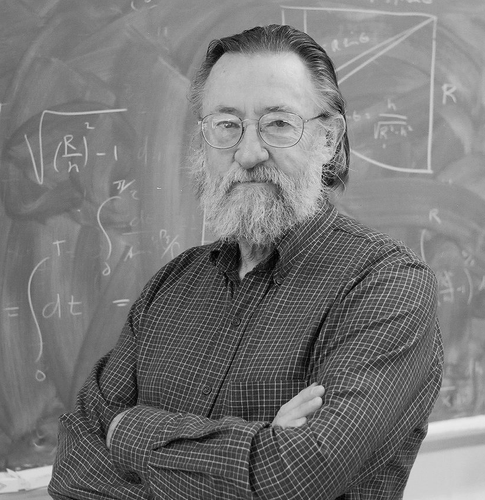Name John Reppy | ||
 | ||
Ml workshop 2012 john reppy status report the manticore project
John D. Reppy (born February 16, 1931) is a physicist who studies the quantum properties of superfluids at Cornell University. He is also a notable rock climber of long standing, who established a number of widely known climbing routes particularly in the northeastern United States.
Contents
- Ml workshop 2012 john reppy status report the manticore project
- 2017 AO Williams Lecture John Reppy Superfluidity Phase Transitions and Topology
- Rock climbing
- Scientific contributions
- References
2017 AO Williams Lecture: John Reppy "Superfluidity, Phase Transitions, and Topology”
Rock climbing
In the 1950s and 60s, Reppy was active on Ragged Mountain in Connecticut where he collaborated on many first ascents and on publishing an area guidebook with Sam Streibert. The well-known Reppy's Crack on Cannon Mountain in New Hampshire bears his name and he has made first ascents as of number of routes in the Shawangunks and elsewhere. He made early attempts on Armadillo, a long alpine rock climb on Mount Katahdin, Maine. In addition, he has climbed extensively in England, the Alps and western America.
Reppy has said his earliest interest in rock climbing as a very young teenager was related to the re-opening of small open-pit mica mines in eastern Connecticut during World War II in response to increased war-time demand for electronics materials.
Reppy was among the first climbers in the United States to practice so-called "clean climbing" techniques, which he learned in England. While most climbers of the day were hammering their way up the cliffs with pitons, Reppy helped introduce the use of nuts, which at the time consisted of hex nuts from truck wheels, strung with nylon webbing. Unlike pitons, nuts are placed and removed without the use of hammers and save the rock from permanent damage. The technique often makes placements easier and faster to achieve, and thus may make difficult climbs easier to complete. Many advances in rock climbing were made possible by this method. Among a substantial number of others deserving credit for this trend in the U.S. are Yvon Chouinard and John Stannard.
Scientific contributions
Reppy received a bachelor's degree in math and physics in 1954 at University of Connecticut and a master's degree from the same school two years later. He completed a Ph.D at Yale University in 1962, where he spent four years as an assistant professor. Reppy joined the Cornell Physics Department in 1966, later becoming the John Wetherill Professor of Physics. He is the recipient of numerous awards and honors, including the Fritz London Memorial Prize in 1981 and the NASA Distinguished Public Service Medal for leadership and support to the NASA microgravity fundamental physics program in 2000. Reppy is also a member of the National Academy of Sciences.
As physics professor at Cornell University, he studies quantum properties of superfluids with an emphasis on boundary conditions and phase transitions in systems of reduced dimensionality. His research group has a close association with those of David M. Lee and Robert C. Richardson also of Cornell, who shared the 1996 Nobel Prize in Physics with Douglas D. Osheroff for discoveries related to super fluidity in helium-3 ice. Lee, in his Nobel Prize speech, credited Reppy's "extraordinary technical ingenuity" in experiments leading to the discovery. In the speech, Lee made other references to Reppy, noting that his work helped confirm related insights.
Reppy also figured at least on the fringes of the 2001 Nobel Prize for Physics which was awarded to Eric Cornell and Carl Wieman of the Joint Institute for Laboratory Astrophysics, or JILA, in Boulder, Colo., and Wolfgang Ketterle of the Massachusetts Institute of Technology. Bose–Einstein condensation was predicted in 1924, and was seen decades ago in liquid helium, according to Ketterle, who acknowledged a controversial earlier claim by Reppy. Ketterle says that Reppy brought this finding to his attention, and that the priority claim was fair. "I think the results appeared conclusive", Ketterle reportedly said. But co-laureate Wieman said that Reppy's claim is "really a stretch" and that Ketterle may have acknowledged the helium experiments merely to appease Reppy. "Ketterle is being gracious", Wieman reportedly said, "and Reppy makes a lot of noise."
Physicists generally agree that the atoms in superfluid helium-4 is not a Bose–Einstein condensate in the original sense of the term because its atoms interact too strongly. Reppy studied an exception: tiny amounts of helium trapped in nanometer-sized pores of a spongelike glass called Vycor. Even though the pores keep its atoms too far apart to jostle one another much, the helium still behaves like a three-dimensional fluid. In 1983 Reppy and colleagues reported results that suggested the helium was sloshing through the glass as a true Bose–Einstein condensate.
Separately, work from Cornell physics laboratories has been used to test a theory of cosmic strings, hypothetical objects, which may have been important in the formation of galaxies, and may have arisen through "phase transitions" in a fraction of a second after the Big Bang.
